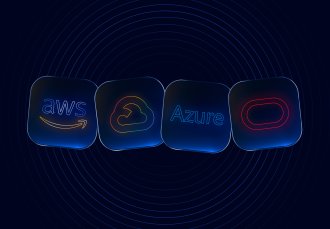
Contact us
Our team would love to hear from you.

In this article, we will investigate the definition of e-learning and its benefits and types. Moreover, we aim to identify important features of e-learning software, the development process, the costs, and, finally, the benefits of outsourcing e-learning app developers. We will also explore some influential development trends.
UNESCO defines e-learning as all forms of electronically supported teaching and learning, as well as web- and computer-based acquisition of knowledge and skills. Learning with the help of e-learning software can occur both inside and outside the classroom. E-learning provides access to materials for studies and personal development.
Such applications are used not only by educational institutions and individuals but also by many organizations, which create e-learning apps for training. Corporate e-learning development allows companies to instill specific workplace skills in their employees and provide staff with additional resources for pursuing continuing education in areas of interest. Learning and development (L&D) departments dedicated to e-learning are therefore necessary.
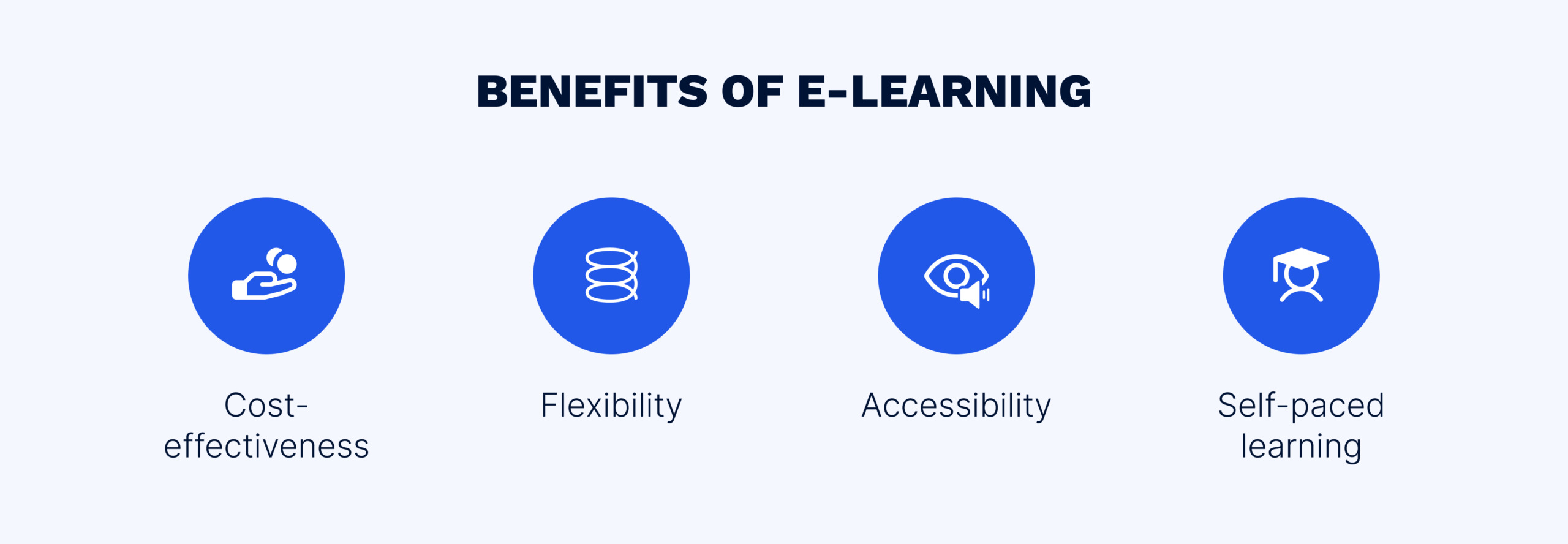
The popularity of e-learning is increasing with the growing accessibility of digital technologies. This trend is hardly surprising, as this education model provides many benefits to both learners and instructors. The following are the primary advantages of e-learning.
E-learning can be asynchronous and is not location dependent, allowing users to develop their skills and acquire knowledge whenever and wherever they want. Thanks to e-learning, even people with the busiest schedules can find time for their studies and combine work and studies, being able to attend a course from anywhere.
There are different types of learners. Some perceive and memorize information easily when it is presented graphically, some prefer listening, and some focus better when reading or writing down the information. E-learning programs utilize various types of multimedia and content that are accessible to different groups of learners. Companies can create e-learning applications that provide information using different methods and address users’ needs.
Taking an e-learning course is significantly cheaper than attending a course in person. Many aspects of traditional education do not apply to e-learning, such as instructors’ salaries, classrooms, and printed learning materials. The number of learners who can use such software is unlimited and requires only a one-time investment.
Most e-learning apps do not require synchronous learning, meaning that the participants of the educational process do not need to interact with each other at the same time. This allows app users to choose a learning pace suitable to them.
There are different types of e-learning platforms that enhance the provision and management of learning services.
Self-study apps provide a convenient way for users to develop their skills and extend their knowledge in a subject of interest. Personal learning software allows learners to study in a way that is suitable to them, focusing on their goals and objectives and free from place or time restrictions. Usually, these apps include pre-uploaded courses that users can access, allowing them to choose from a variety of available categories. There are also personal learning platforms that specialize in a particular subject (e.g., language learning apps, code learning apps, music education apps, etc).
With digital transformation revolutionizing education and other industries, many companies recognize the importance of corporate staff training. E-learning software for organizations is designed to meet specific needs and teach the skills necessary for positions in the organization. A company-wide application is a valuable asset for employees, who can use such apps to perform their job duties and acquire additional skills in areas of interest.
LMS software is used to deliver educational courses and administer, document, report, and track the learning process. In corporate L&D, LMSs can help employees by providing onboarding and compliance instructions, as well as materials for developing hard and soft skills. These practices enhance employee satisfaction and loyalty. Another use case for LMSs involves training customers to help them understand how a product or a service works. Teaching customers how to make the best use of the product promotes its adoption and improves customer engagement.
LXPs resemble LMSs, and they provide an effective way to enable employee training. However, these two types of e-learning software pursue different goals. While an LMS is managed by an administrator and ensures that all users receive the same knowledge, LXP content can be provided by platform users as well. These apps enable customized recommendations based on previous search history and put learners in charge of their development. LXPs are open-source systems that serve as content aggregators with links to a company’s LMS, electronic knowledge bases, and other learning resources.
E-learning authoring tools are used to create learning content. They are important assets for L&D professionals and instructors aiming to develop engaging and effective programs for learners. Authoring tools allow users to create customized courses, lessons, and other material in accordance with specific needs. This content is then uploaded to learning platforms. Enterprises, for example, may use e-learning authoring tools to design specific courses for their employees to complete in a corporate LMS.
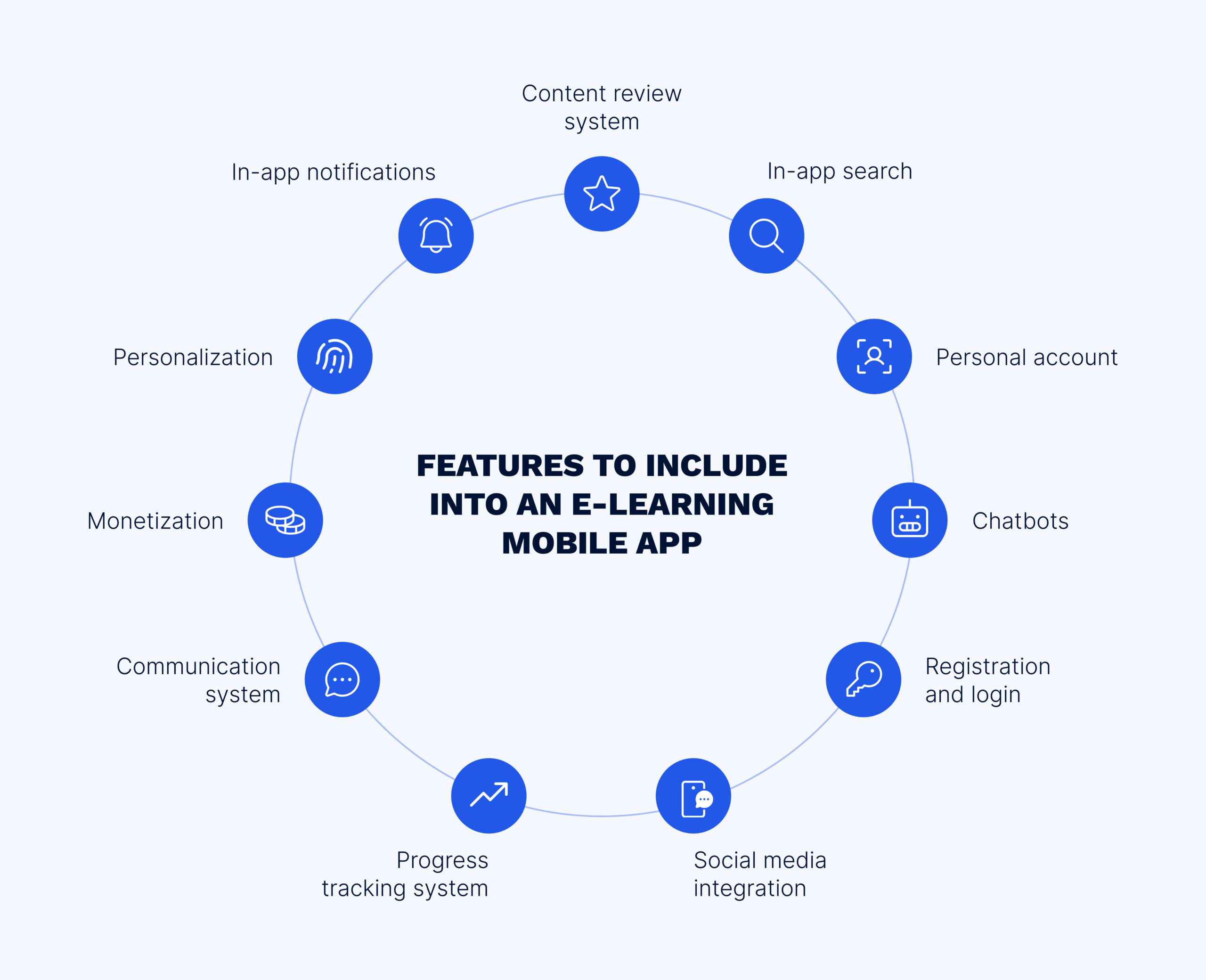
In addition to the learning materials, e-learning apps must include features that enhance user experience and attract audiences. Here are some important features and functions to consider:
Simple registration and login when opening an e-learning app is the first step of a learning journey. This feature impacts trustworthiness, as app users provide their personal information and must feel confident that it is secure. Registration and login should be compliant with data regulations, while also featuring a “remember me” option so learners do not have to enter their information every time.
Upon registration, users should be able to access their own space, such as a dashboard or an account page. This space should contain important information, such as their personal data and the course they are taking, as well as instructors, assignments, and other applicable aspects, depending on the type of e-learning app.
A tracking feature is useful for both app providers and app users (i.e. instructors and learners). It helps measure progress, showing users how much they have improved their skills, noting areas of strength, and indicating topics that need extra attention, while instructors can use this information to enhance the course materials. Tracking progress also motivates users to keep learning.
A unique experience is another aspect that influences loyalty. Using a learner’s data, an application can be customized to meet customer needs and provide special offers and recommendations. In-app personalization improves engagement by providing content tailored to the learner’s characteristics.
Push notifications are a helpful feature that enhances user experience by keeping learners updated and interested. Notifications can remind users to take a class, complete their assignments, or meet a payment deadline.
There are various monetization methods available—for example, paid apps, in-app purchases, and advertising. Monetization requires a secure in-app payment gateway that helps simplify the transaction process for e-learning users and providers. A payment gateway is a necessary feature that allows users to make convenient and safe payments.
Communication between app users is a vital aspect of the learning process. A messaging system gives users access to online classes, learner-to-learner and learner-to-instructor conversations, and all the other interaction models necessary to provide a comprehensive learning experience. A video call option can be advantageous for some types of e-learning software.
The ability to search for information serves as a supplementary feature that is useful for some e-learning platforms. Search functionality allows users to access information easily and quickly. Search engines can help find a course, an instructor, the necessary material, and other information. App designers may add filters, categories, and recommendations to enhance the search engine feature.
To keep up with industry trends and encourage users to share their progress, e-learning apps require a social media integration feature. This not only allows learners to get support from their friends but also serves as a marketing opportunity for e-learning platform providers. By sharing how their studies are going, users attract other people to use the app.
This feature allows users to leave feedback about the courses they take, as well as share their thoughts and assess each course’s relevance and effectiveness. Thus, learners can see the popularity of a particular course before they enroll, while educators can improve the content of their courses based on the reviews.
AI-powered chatbots can considerably boost user experience by providing round-the-clock assistance. Learners can turn to bots to query information regarding educational processes, IT issues, or administrative procedures. Virtual assistants help resolve these and other questions. Moreover, they support learners throughout the course via an automated communication channel.
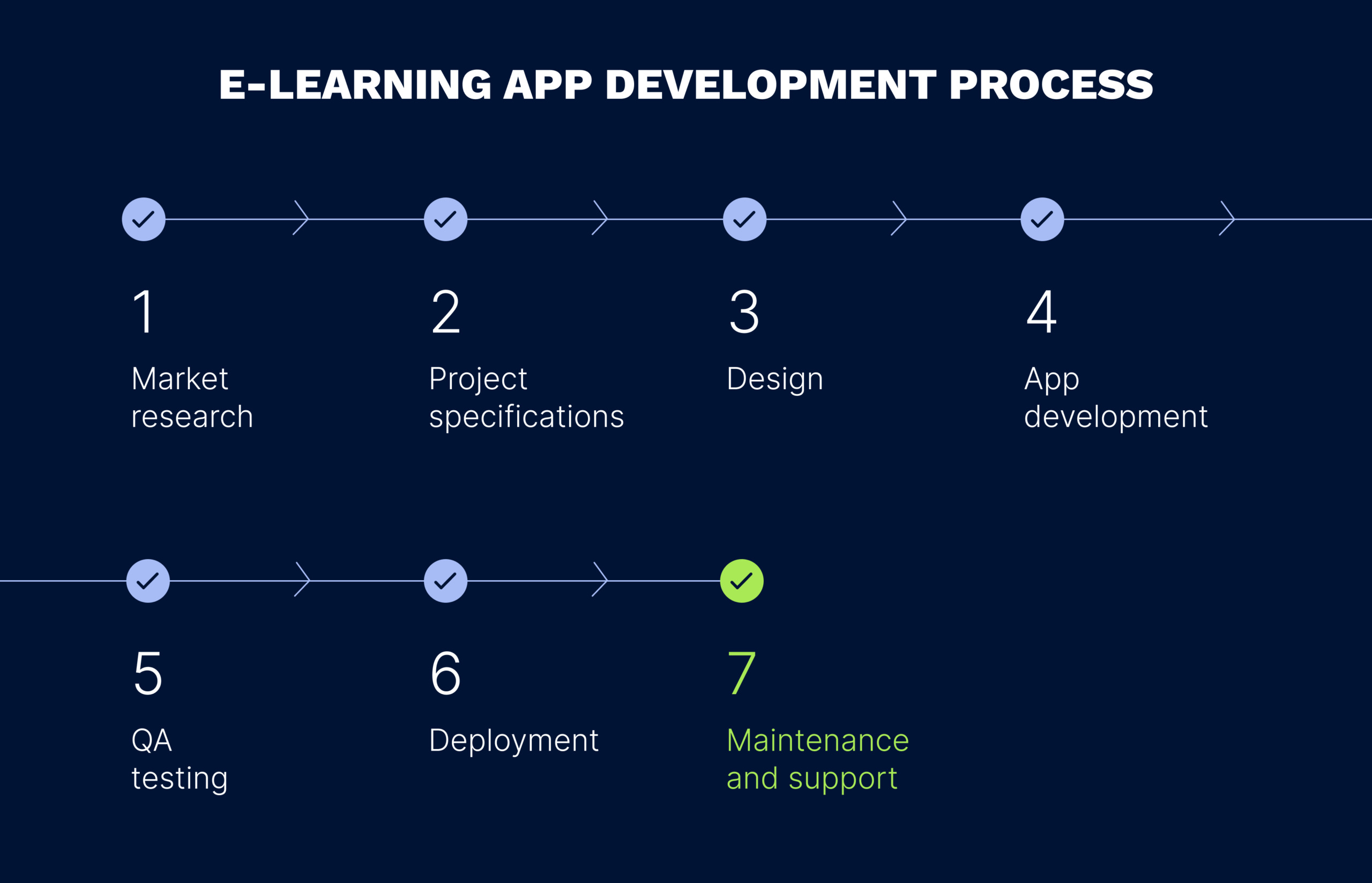
A software building process involves numerous steps that depend on the team, the development model, and the needs and objectives of the client. The following are common e-learning application development steps.
Conducting industry and market analysis is crucial to assessing unmet customer needs and determining the best path to succeed. Since e-learning is a popular domain, market research can help a company identify a competitive advantage.
This step includes defining the target audience, setting project objectives and milestones, choosing the technology stack, preparing the documentation, building a team, and estimating the budget and duration of the project.
Before the development starts, a design concept is proposed and approved. Objectives and the target market are the focus at this step. The design concept allows clients to see the appearance and UI layout of the application, test the way it will be used by learners and instructors, and make initial changes. In e-learning apps, simple navigation and a friendly UI require extra attention.
The development of e-learning software requires a skillful team that can deliver stellar results. An app is built according to the specifications, design concept, and requirements determined earlier. First, a minimum viable product version of the app is created and offered to customers to solicit initial feedback. Later, supplementary features are added.
QA is the last step before the product is ready for release. Testing is an essential step in creating an app, this stage helps detect errors or bugs and ensures high quality. QA combines automated and manual testing depending on the tested aspect of the product. For example, when evaluating an app from the learners’ or instructors’ point of view, manual testing is required, while automation is suitable for app elements that require repeated evaluation.
The deployment, or launch, involves publishing the e-learning software on app stores, following submission guidelines, and building a marketing campaign to promote it. Different target audiences have different values that should be addressed in a marketing campaign.
After the final delivery of the e-learning app, continually updating and improving it remains crucial. When learners and instructors start using the software, they leave feedback that is useful for making changes and enhancements. Maintenance and support encourage quality service delivery and customer loyalty when they see that their needs and requests are heard and met.
The final price of an e-learning app can start at $20,000 and increase with the complexity of its features and design. To estimate the cost, it is important to understand the variables that influence it. Here are the main price-forming aspects.
E-learning mobile application development has three primary platform options: Android, iOS, and cross-platform solutions. Each requires different technologies, time, and resource investment. These options have their own benefits. For example, a native Android or iOS solution performs better and is more secure, while a cross-platform app reaches a wider audience.
Different types of e-learning apps require different sets of features. Depending on the target audiences, their needs, and the desired level of personalization, the complexity and price of the software can vary. At the beginning stages of app development, the cost of each feature can be estimated to determine what it adds, not only to the value of the solution but to the final price as well.
To keep learners and instructors engaged and gain their loyalty, it is necessary to design a sophisticated e-learning app that corresponds to the latest trends and user expectations, meets all requirements, and is easy to interact with. The more complex the design, the higher the price of an app. Custom elements such as animation, interactive UI mechanics, and controls help enhance user experience but considerably increase the cost.
Following the latest technology trends provides users with the best experience and helps an app stand out among competitors. The world of technology is fast-moving, and there are many options available for e-learning application providers to employ. Such solutions include artificial intelligence and machine learning, augmented and virtual reality, and blockchain. However, the integration of advanced technologies significantly increases the cost of an e-learning application.
Organizations should consider hiring an e-learning app development company when estimating the budget. When resorting to outsourcing, companies are likely to find that the market has much to offer. The choice of the development company and its rates depend on the expertise and the country where it is located. If you are looking for experts in e-learning app development, contact EffectiveSoft. We have a proven track record and considerable experience in building educational solutions.

When embarking on the e-learning app development journey, the first thing that must be decided is whether to build your own development team or turn to outsourcing. Though for some companies a product team could be a good option, outsourcing offers many advantages that influence the final choice.
When beginning with an idea for an e-learning app, it can be difficult to create a development team from scratch. Outsourcing services give access to specialists who already know the best way to build mobile software with maximum profit and minimal risks. The skills and knowledge of outsourced developers can help you transform an idea into a powerful solution that meets or even exceeds expectations.
The expertise and skills of outsourcing development teams allow them to provide valuable solutions. No matter the question or issue you encounter on your development journey, they have likely solved similar problems before and know how to do it flawlessly. Outsourcing teams have knowledge of different domains and can advise innovative solutions, resulting in high-quality, user-friendly software.
By choosing outsourcing, you can significantly reduce the amount of money you would spend hiring your own team, especially when contracting with vendors in countries with low development rates. Recruiting and keeping an in-house development team incurs many expenses, such as hiring, salary, benefits, sick leave, training, office equipment, and electricity. IT services vendors handle all these arrangements.
When you come up with an e-learning app idea, there are numerous steps you must take before it is fully realized. Turning to an outsourcing vendor eliminates those steps and allows you to begin the development right away. Another aspect that impacts time to market is expertise. Even if you build your team, there is a chance you may not get it right on the first attempt, while outsourced teams have the experience necessary to provide powerful solutions quickly and effectively.
Software development is a process that must adjust to constantly changing industry and user requirements. Outsourcing makes it possible to quickly and painlessly upscale and downscale the development teams. It is possible to engage necessary specialists for one part of a project only, enabling the required changes to comply with client and market demands.
IT outsourcing has become a popular service. It helps businesses focus on their main activity while delegating the software development task to experts. In the case of e-learning, this is not only beneficial to educational institutions. Company training platform development is necessary for any company that needs to educate their employees and develop their skills.
There are different types of outsourcing that can be beneficial depending on the situation. Staff augmentation is suitable when engaging one or several experts for a particular task. Dedicated teams are employed for a certain stage of product development. Project-based outsourcing is used when an outsourcing company takes over the whole development process from the idea to a finished custom solution.
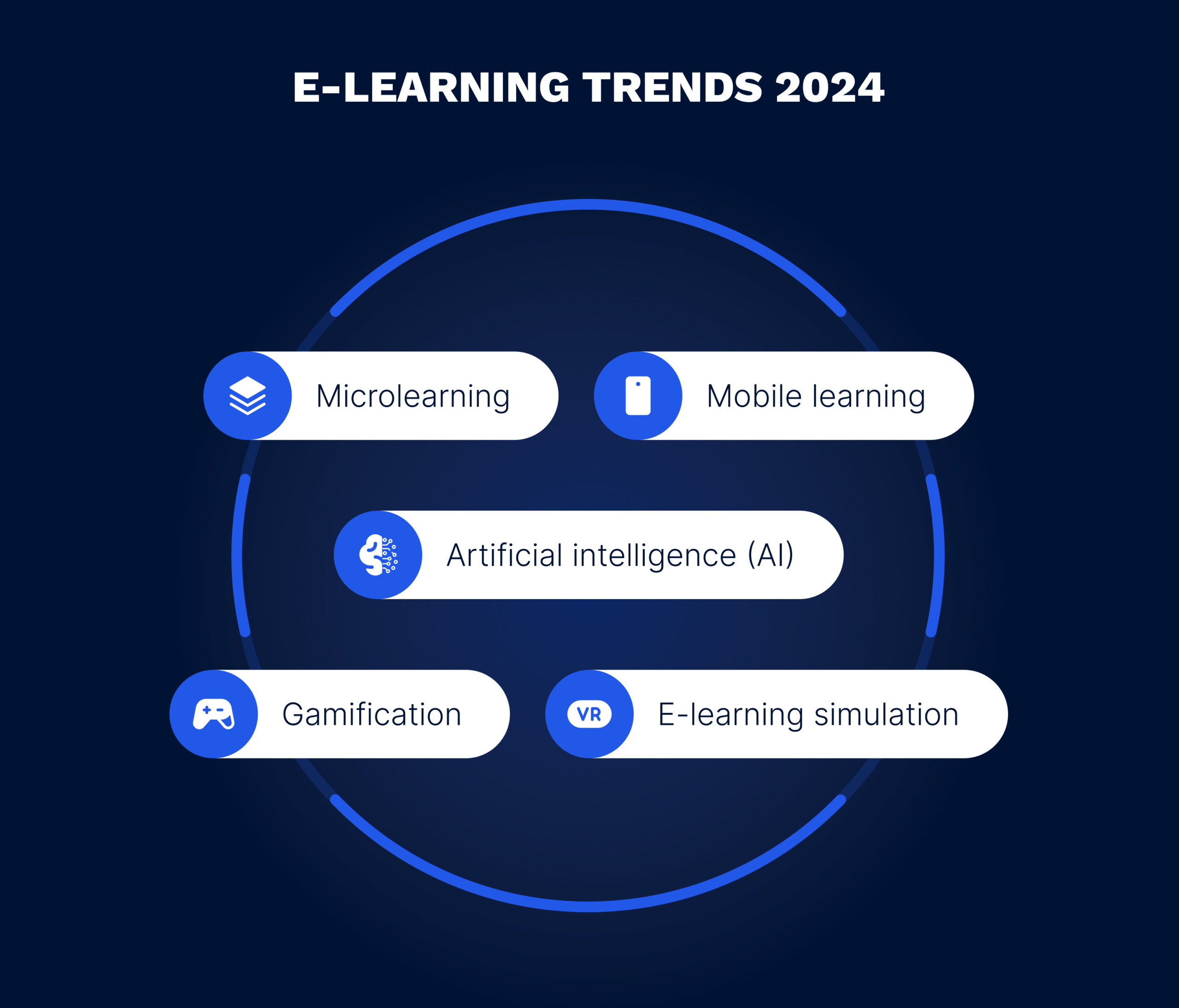
Since technology is an integral part of e-learning, new e-learning industry trends appear as it advances.
AI is a leading trend for many industries and spheres. It automates and optimizes processes, driving positive change, such as increased efficiency and streamlined workflow. E-learning can employ this technology to power chatbots and assistants that answer questions and provide constant support, enhance personalized and adaptive learning, and create content for studies. These use cases have the potential to significantly increase learner satisfaction and engagement.
Microlearning apps break down complex topics and ideas into small portions that are easy to comprehend and absorb. People can then effortlessly recall information that they experience in tiny bits and review regularly. This process is advantageous compared to engaging with large amounts of information that is forgotten easily when it is not used in practice.
E-learning simulation software is effective for practical training. By using such apps, learners gain hands-on experience by performing a training task in a controlled, risk-free environment. The interactive and immersive experience provided by e-learning simulation apps helps users build skills and increase knowledge by practicing a certain activity.
It is hard to imagine modern life without smartphones. That is why a mobile application is a must for an e-learning platform. Having an app at hand encourages mobility and enhances user loyalty. Users can learn in a convenient way with the opportunity to take a course whenever they have a spare minute (e.g. while commuting or between errands).
The incorporation of game mechanics into learning is another trend in the education industry. E-learning gamification software provides an environment that motivates users and helps them retain the material by engaging them in the learning process through quests and rewards. Game elements in e-learning apps increase productivity through competitiveness. For instance, points or other reward bonuses may be given for correct answers or completed lessons. Learners are then hooked to continue using the application.
E-learning software is crucial in supporting the audience’s knowledge acquisition. Companies in various industries develop such apps to maintain a high level of skills among their employees. The main benefit of e-learning is that it is free from time and place limitations so that learners can control their training experience. Engaging such trends as microlearning, AI, simulations, and gamification can significantly improve e-learning outcomes.
To find out more about e-learning development and partner up for a project, contact our specialists. We are ready to help!
Our team would love to hear from you.
Fill out the form, and we’ve got you covered.
What happens next?
San Diego, California
4445 Eastgate Mall, Suite 200
92121, 1-800-288-9659
San Francisco, California
50 California St #1500
94111, 1-800-288-9659
Pittsburgh, Pennsylvania
One Oxford Centre, 500 Grant St Suite 2900
15219, 1-800-288-9659
Durham, North Carolina
RTP Meridian, 2530 Meridian Pkwy Suite 300
27713, 1-800-288-9659
San Jose, Costa Rica
Escazú Corporate Centre, Piso 6
40602, 1-800-288-9659